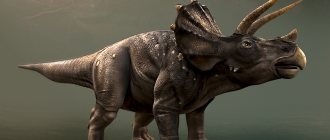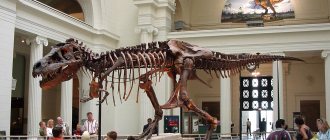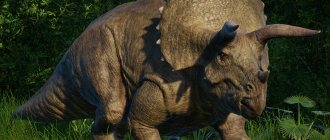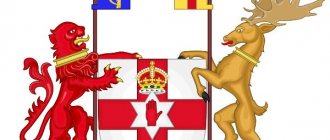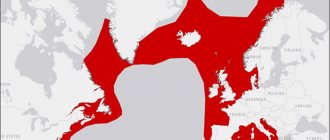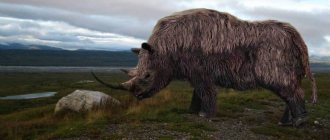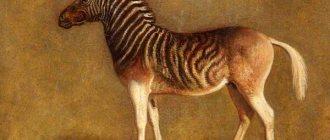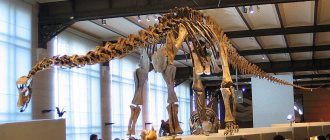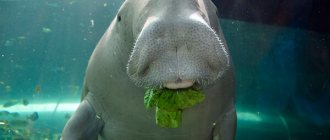Pterodactyl is the first of the discovered pterosaurs: it was described back in 1784, and received its name in 1809. In subsequent decades, almost all newly discovered pterosaurs were called pterodactyls, and this designation took root so much that in the public consciousness the terms “pterosaur” and “ pterodactyl" have become synonymous.
Due to its external similarity, pterodactyl is often confused with pteranodon.
This is true to some extent, as pterodactyls are a large group of pterosaurs that have lived since the late Jurassic period. However, the name for this group was given by a medium-sized lizard that lived in Europe about 150 million years ago and left little evidence of its life.
Pterodactyl: description
The Latin name has Greek roots. It is translated as “winged finger”. The name is associated with the presence of a long fourth finger on the forelimbs of this fossil representative of flying lizards, with which a flying wing was associated. Pterodactyls were identified as a genus/suborder, which is part of the large order of pterosaurs. At the same time, they consider them to be the first described pterosaurs, and even quite famous flying lizards, known throughout the history of paleontology.
PTERODACTYL - FLYING LIZARD OF THE AGE OF DINOSAURS
Appearance and dimensions
It is difficult to compare the pterodactyl with a flying lizard, since it was more similar to a clumsy bird with a huge pelican-like beak and huge wings. It should be noted that the pterodactyl was not impressive in size, which was typical for that time. The wingspan of this flying dragon did not exceed one meter. As some finds indicate, other types of pterodactyls were characterized by even smaller sizes. Adult digitopterans were characterized by the presence of a long and thin skull, as well as long thin jaws armed with conical needle teeth.
The front teeth were the largest, while towards the throat their size gradually decreased. The skull and jaws, compared to other related species, had a straight shape without any bends. The neck was elongated and quite flexible, without the presence of cervical ribs, but the cervical vertebrae could be seen. On the back of the head there was a high crest, the size of which increased as the flying lizard grew older. Fingerwings were distinguished by good flying qualities, despite their size. Similar characteristics were provided by the light, hollow bones that formed the basis of the leathery wings.
Important point! The wing of a pterodactyl is nothing more than a large fold of skin that is “attached” to the fourth finger and to the bones of the wrist. The hind limbs were somewhat smaller than the forelimbs, the fourth finger of which had a length equal to half the length of the limbs. At its end grew a long claw.
The flying fingers had the ability to fold. The wing membrane consisted of thin muscles protected by skin and supported by keratin ridges on the outside and collagen fibers on the inside. The pterodactyl's body was covered with light down, which created the appearance of complete weightlessness against the backdrop of huge wings. It should be noted that Johann Hermann in 1800 painted the pterodactyl as quite plump, although experts note that it had a thin and narrow body.
As for the tail, there is no general opinion among experts, since some believe that pterodactyls did not have a tail, while others believe that it did exist, but disappeared during the process of evolution. Those who spoke about the presence of a tail. It is believed that pterodactyls needed it for a comfortable existence in the air. The fact that the tail disappeared, according to biologists, is due to their brain, which grew and developed, which led to the disappearance of the tail.
Character and lifestyle
According to experts, pterodactyls led a gregarious lifestyle, which indicates their high level of organization. Basically, they led an active lifestyle during the daytime. Until now, experts are puzzling over whether they flapped their wings in flight, especially since free soaring in the air is not subject to any doubt. Most experts prefer flapping flight, although its technique was somewhat different from the flight technique of modern birds. Most likely, pterodactyls carried out slow and infrequent strokes in flight, like albatrosses, for example. Naturally, sharp flapping of wings was considered inaccessible to them.
After each flap of its wings, the flying lizard gave itself up to free soaring. Naturally, the long neck and massive head interfered with the flight process, so we can only guess. How pterodactyls managed to fly. Disputes are hovering over another serious problem, how the pterodactyl managed to take off before the flight. Some scientists believe that pterodactyls easily took off from any surface, including water.
Interesting to know! Some opponents believe that it was difficult for pterodactyls to take off, especially since to do this they must be at a certain altitude. To climb to heights (on a rock, cliff or tree), the flying lizard used sharp claws.
It is believed that fingerwings easily climbed any surface, but they were clumsy when moving on the ground, as they were hampered by folded wings and bent fingers.
They felt much more comfortable on the water, since the membranes between the fingers turned into a kind of flippers. Flying lizards had excellent vision, so they could observe the movement of schools of fish from a height. While in the air, pterodactyls felt most safe. They spent their sleep with their heads down, like bats, clinging to some ledge or tree branch with their tenacious paws.
How long did pterodactyls live?
Pterodactyls were warm-blooded animals, so the lifespan of these animals was calculated similarly to the lifespan of modern birds of similar sizes. Therefore, birds such as eagles and vultures, whose lifespan reaches up to 70 years, were taken as a basis.
Hellish creature
In 1925, English journalist J. Ward Price accompanied the Duke of Windsor on an official trip to Rhodesia. Among other correspondence, he sent an article to Great Britain about a certain black man. He, having allegedly learned that there were demons in one of the local swamps, decided to make sure of this. The brave aborigine swam on a boat into the swamp, but returned from there without it, but with a large wound on his chest. It looked like he had been hit with a spear. The African said that he was attacked by a large bird with a long beak. When he was shown a drawing of a pterodactyl, the brave native said that he had seen exactly this creature. In 1932, the American scientist and adventurer Ivan T. Sanderson was attacked by a flying monster with a large toothy mouth in the Asun-bo Valley. To escape from the Olityau, as the natives called the monster, the zoologist jumped from the boat into the river and dived. Emerging, he grabbed a revolver from the boat and shot at the monster, but it remained alive and flew away. Sanderson described the creature as being like a huge eagle with a long, sharp beak and many small teeth, with a wingspan of about three and a half meters. However, the range of modern pterodactyls does not seem to be limited to Africa. A number of cryptozoologists believe that they can also be found in Alaska, Texas and the Mexican highland Sierra Madre Oriental region. In Texas, there were especially many sightings of these living fossils in the 1970s. It got to the point that a certain Armaldo Grimaldo was taken to the hospital with injuries inflicted on him by a “hellish creature” that had descended directly from heaven. Eyewitnesses of this truly wild incident, looking at the image of a prehistoric pterodactyl, unanimously insisted that it was him.
Discovery History
The skeleton of a pterodactyl was first discovered in Germany, in the Solnhofen limestone deposits.
Misconceptions
In 1870, a collection of an unprecedented beast, represented by its remains, appeared in the private collection of Count Friedrich Ferdinand. After four years, these remains were described by the French historian and Voltaire's own secretary, Cosmo Alessandro Collini. He oversaw the natural history office opened at the palace of Charles Theodore in Bavaria. The remains of this creature received the status of the earliest discovery under the name of pterodactyl and pterosaur.
Important fact! There is one more skeleton, which can rightfully be considered the first discovery. This is the so-called “Pester specimen”, which became known back in 1779, but which was initially classified as an extinct species of crustacean.
Collini, who described this creature, believed that it did not represent a species of flying animals, but belonged to representatives of the aquatic fauna. This theory has been supported for a long time at various scientific levels.
In 1830, German zoologist Johann Wagler wrote an article concerning certain amphibians, which was supported by an image of a pterodactyl. Wagler not only presented the public with an image of a flying lizard, but also classified it into a special class of animals, located between birds and mammals.
Hermann's hypothesis
The French zoologist was the first to realize that the fourth finger of the pterodactyl serves to hold the wing membrane. It was this zoologist who first informed Georges Cuvier that there were interesting remains. He was worried that Napoleon's soldiers would not take them to Paris. Along with a letter in which he laid out his own interpretation of the origin of the fossils, Jean Hermann sent a black and white drawing that depicted a creature with outstretched, rounded wings that originated from the ring finger.
Based on the appearance of bats, Herman placed a membrane in the gap between the neck and wrist, although the membrane and fur were absent in the sample itself. Despite the fact that he himself did not take part in the research, Herman identified this creature as an animal. Despite some facts, Cuvier liked the interpretation of the image of a mammal, which served as a source for Cuvier's further works. The only thing Cuvier did was identify the remains as reptiles.
Interesting to know! In 1852, a bronze monument to a pterodactyl was to be installed in the garden of plants in Paris. It is unknown for what reasons, but this was not done, although this project was implemented two years later. In fact, the monument was erected not in France, but in England in the newly opened Hyde Park.
They called him a pterodactyl
In 1809, the same Cuvier described the flying lizard in more detail, which the public learned about. In this work, he was the first to name the find “Ptero-Dactyle”, which translated meant “wing and finger”. In addition, Cuvier was the first to destroy the myth that this species belonged to coastal birds. During the same period of time, it became known that the French army did not remove these remains, since they were in the possession of a German physiologist. While he was examining the remains, information appeared in the press that the remains had disappeared. When the physiologist read this message, he notified Cuvier that no one had stolen the find.
In 1812, a German physiologist wrote an article in which he said that this creature is an intermediate species between birds and bats.
Cuvier published a counter article in which he insisted that the remains belonged to an ancient reptile. In 1817, another specimen of pterodactyl was found, which was significantly smaller in size.
Important point! Back in 1815, an American zoologist, having read the works of Cuvier, proposed using the term “Pterodactyl”.
In our time, scientists, armed with the latest advances in science, have conducted a thorough analysis of the remains. As a result of this, it was established that there was a single species of pterodactyl.
This terrible congamato
Among the pterosaurs of our day, the most famous is the ominous African monster congamato, living among the swamps of western Zambia. Cryptozoologists consider its main nesting area to be the Mwinilunga region in the Jindu swamp area, near the border with Angola and the Democratic Republic of the Congo. In 1912, the British explorer Frank Malland visited those places, who was very puzzled by the stories of the natives about a bird living there, which was not a bird at all. After Malland showed representatives of the local Kaonda people a book with an image of a pterodactyl, they easily recognized it as the monster Kongamato. Later, in his 1923 book In Witchbound Africa, Malland described the kongamato as an aggressive and dangerous creature that lives along some rivers, often attacking small boats and anyone who disturbs it. It was usually described by local residents as having a brown or black color, with a wingspan of up to seven meters. Africans also claimed that the kongamato had an evil eye, and even a fleeting encounter with it was dangerous. Legends about similar creatures are also known in Angola, Zimbabwe, the Democratic Republic of the Congo, Namibia, Tanzania and Kenya.
Where did pterodactyls live?
Pterodactyls lived on our Planet 152-145 million years ago, appearing in the Jurassic period and disappearing in the Cretaceous period. Some scientists believe that pterodactyls lived exclusively in the Jurassic period.
Interesting fact! Almost all of the fossilized remains were found in the Solnhofen limestones and only a small part belongs to some European countries, as well as Africa, America and Australia.
As a result of the findings, scientists suggest that pterodactyls lived over fairly wide areas. The remains of pterodactyls were found in 2005 on the banks of the Volga River.
Habitat
The main habitat of pterodactyls is the territory of modern Germany. Small fragmentary remains of the pterosaur have also been found in other parts of Western Europe and Africa. If we talk about representatives of the suborder of pterodactyls, which included, for example, Quetzalcoatlus, then they became very widespread. Therefore, fossils of pterodactyl's closest relatives are found not only in Europe and Africa, but also in Australia, North and South America, and Russia. Common features for representatives of the suborder were a crest, a short tail, and a long skull.
Reproduction and offspring
Since pterodactyls preferred to live in numerous groups, their nesting sites represented numerous colonies. Their nests were located as close as possible to bodies of water, so they placed their nests on steep cliffs. According to experts, flying lizards were responsible parents. They cared for their offspring and also taught them survival skills in the environment.
Natural enemies
Pterodactyls occasionally became victims of ancient predators, both terrestrial and winged . Among the latter were close relatives of pterodactyl, rhamphorhynchus (long-tailed pterosaurs). Descending to the ground, pterodactyls (due to their slowness and sluggishness) became easy prey for carnivorous dinosaurs. The threat came from adult compsognathians (a small type of dinosaur) and from saurian-hipped dinosaurs (theropods).
Return to content
